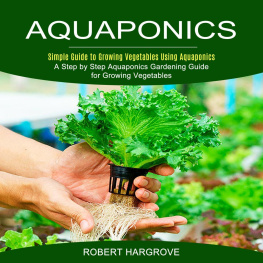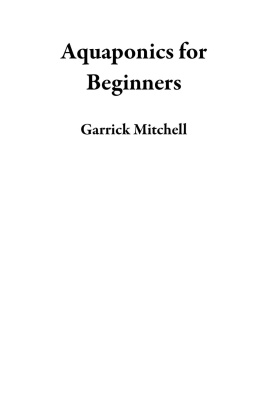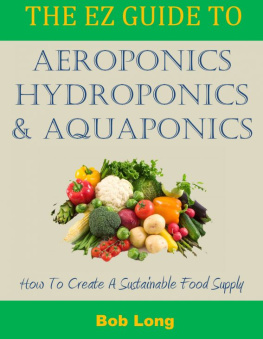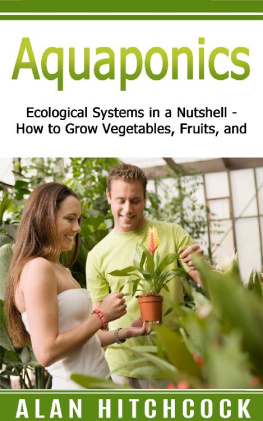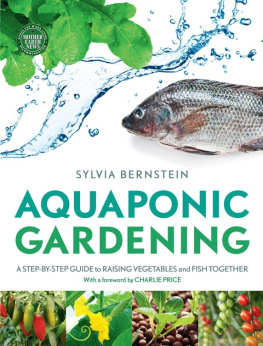Aquaponics: Simple Guide to Growing Vegetables Using Aquaponics (A Step by Step Aquaponics Gardening Guide for Growing Vegetables)
Robert Hargrove
Copyright 2021, Robert Hargrove
Legal Notice
All rights reserved. Without limiting the rights under the copyright reserved above, no part of this publication may be reproduced, stored in or introduced into a retrieval system, or transmitted, in any form, or by any means (electronic, mechanical, photocopying, recording, or otherwise) without the prior written permission of the copyright owner and publisher of this book. This book is copyright protected. This is for your personal use only. You cannot amend, distribute, sell, use, quote or paraphrase any part or the content within this eBook without the consent of the author or copyright owner. Legal action will be pursued if this is breached.
Table of Contents
Introduction
Take a look at your free gift

Click here to get instant access
Aquaponics is an excellent method to raise fish and other food items in a single space, however the main problem for many people is how to make it work. Since a lot of plants do well in aquaponics, it's easy to become overwhelmed and want to cultivate every single thing! If you have the right setup it's possible to do this but it'll be more difficult to grow healthy plants if your a novice, so it's a great suggestion to start with a with a small. In the same way, even if selected plants that are already growing in a way that is suitable for your space, it could be the most difficult task.
An aquaponic setup could be as simple as an aquarium with fish in it and a pot over it, however this isn't very effective. If you're confident with the basic concepts of aquaponics then this is the perfect guide to figure out the best method to make the most of your space and cultivate any plants you'd like to.
The main thing you need to consider when setting up an effective aquaponic setup is to make sure that your plants are getting their three primary needs met that is water, light and nutrients. Since nutrients and water are both the same thing, it means that the growing area must be sufficiently flooded or the plants will fail to thrive. Too much water is, however could cause them to rot. If you're not familiar with the basics of aquaponics laying down, the road ahead of the game. This is an intermediate guide to those already acquainted with the basics of how aquaponics operates.
If you're looking for plants to start, you'll have to either source plants that have already been grown in a hydroponic system or grow them yourself using seeds.
Aquaponics seeding isn't that difficult. It's best to begin them with an organic material such as rock wool or coir since they're small and won't split to enable the root system to grow while giving the support that the roots require. It's not recommended to move plants out of soil as there is an extremely high risk of shock. In the same way, transferring plants out of soil can mean there is a risk of introducing the bacteria and other contaminants that can impact your fish. Aquaponic systems are delicate and requires to be kept in check, in both the interest of the health of the fish as well as plants.
For your plants to flourish, it is sometimes necessary to be a bit creative. It's not about better equipment, but rather being more creative with the tools you've got or have access to!
What we'll explore is some innovative methods to increase the size of your plants, and address the most common issues that confront many growers to ensure that your plants are the best they canbe!
Chapter 1: What Is Aquaponics?
Aquaponics is basically a method where plants and fish collaborate to ensure that both thrive. Both are nurtured through the system that is built to make use of the recirculation process of its biological processes. This system of ecological design involves the an excess of waste produced by the fish, which is then treated by bacteria before being transformed to produce plant food that is then used to cleanse the water for fish. Each of them plays a role within the Aquaponics system, which allows people to access a wealth of sustainable, healthy fresh food sources from both fish and vegetation. The system was developed out of the combination of the best aspects that comprise Hydroponics and aquaculture all while eliminating the negatives that come with both, including fertilizer additives made of chemicals as well as the necessity of dumping water, as well as filtration.
History and current uses
Aquaponics might be growing in popularity and usage among commercial farmers and home-grown growers however it's not a brand new idea. We just have the privilege of using the latest and upgraded, as well as much simpler methods of Aquaponics. According to the saying, the past repeats itself, and those who are smart are able to learn from those who came before us. It is never going to stop me from marveling at how long ago, prior to the invention of technology, before machines as well as mass communication and social media, our forefathers were able to come up with such amazing inventions that enabled them to only survive , but flourish in many locations where the environment was believed to be the biggest obstacle.
In a variety of forms or, Aquaponics was used throughout the continent, in areas such as China's rice paddy fields and in Africa and in Italy and throughout the islands as well as through Native Americans, and the Aztecs in Mexico for example, just to mention several. The Aztecs moved to the area now known in the present as Mexico City. The area did not have the best soil for agriculture, and the interior areas were mostly marshy. To adjust to the conditions of this inefficient environment They built numerous floating rafts around the lake, made of materials found in the region, like reeds and mud. On the rafts, they built gardens that made use of the nutrients of the aquatic species found in the lake to feed the plants.
In the past, when people lived off the land (in certain places there are still people who live off the land) it was crucial to be aware of nature, observe the natural process of nature and utilize it in all areas of life. In light of the observations made, we now have Aquaponics now! It is important to remember that third world nations - as the Aztecs long ago had to contend with challenges in their environments, such as poor soil, insufficient water, and a lot of people were hungry. Numerous organizations are now stepping up and introduce Aquaponics due to their speedy food expansion without much water or soil-free gardening abilities. Apart from being a crucial nutritional source of food, the system provides healthy, healthier eating and essential vitamins and nutrients that assist in strengthening the immune system and fighting illnesses. It also helps to stop the spread of illnesses in one area of the globe, it also stops the spread of illness across the globe!
Chapter 2: Types Of Aquaponics Systems
There are a variety of systems utilized in setting an aquaponics plant. Some of the most well-known systems used by the majority homeowners are the beds that are filled with media as well as the NFT (nutrient film technique) and DWC (deep water cultivation).
Media Filled Beds
These are the most basic and most widely used aquaponics system. They are filled and cleaned with rock, including expanded clay as well as other similar substances. Plants can be cultivated in this kind of medium. A pump is employed to transport water out of the tank in which fishes are raised to media beds. Water flows either in a continuous stream over the rocks or flows into the beds of media, which is then removed after a time.
Next page
